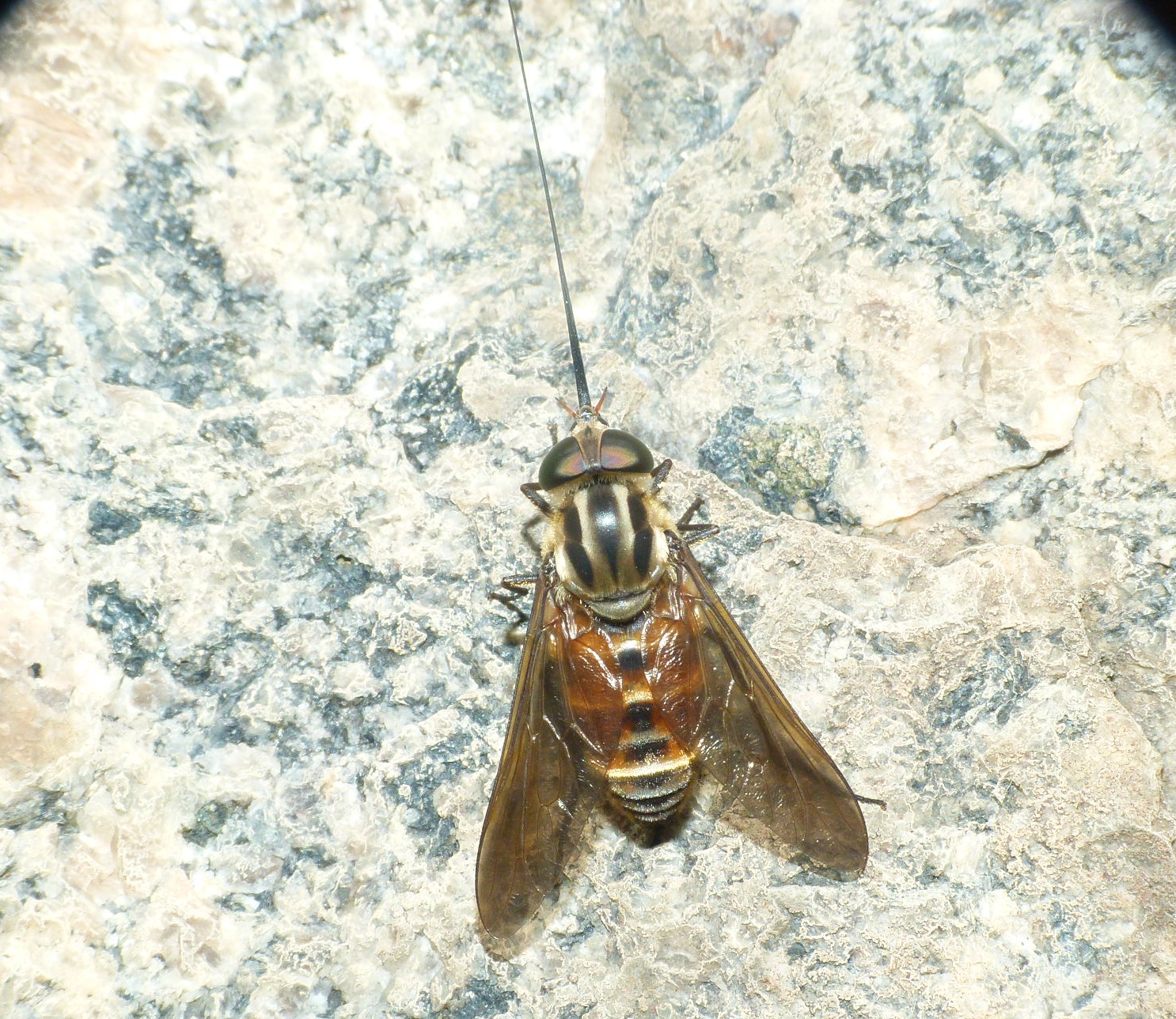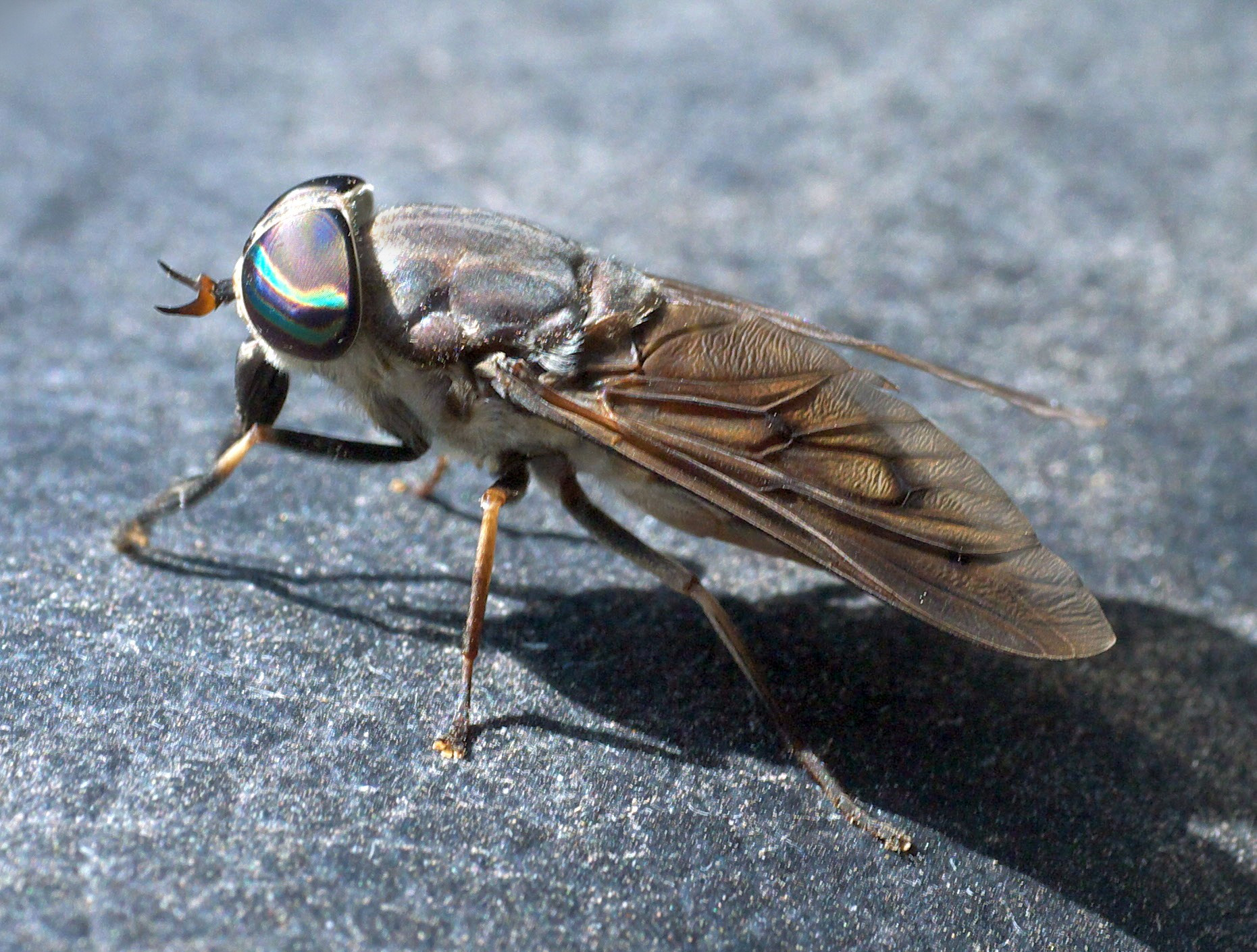|
Tabanidae
Horse flies and deer flies are true flies in the family Tabanidae in the insect order Diptera. The adults are often large and agile in flight. Only females bite land vertebrates, including humans, to obtain blood. They prefer to fly in sunlight, avoiding dark and shady areas, and are inactive at night. They are found all over the world except for some islands and the polar regions (Hawaii, Greenland, Iceland). Both horse flies and botflies (Oestridae) are sometimes referred to as gadflies. Adult horse flies feed on nectar and plant exudates; males have weak mouthparts, but females have mouthparts strong enough to puncture the skin of large animals. This is for the purpose of obtaining enough protein from blood to produce eggs. The mouthparts of females are formed into a stout stabbing organ with two pairs of sharp cutting blades, and a spongelike part used to lap up the blood that flows from the wound. The larvae are predaceous and grow in semiaquatic habitats. Female hor ... [...More Info...] [...Related Items...] OR: [Wikipedia] [Google] [Baidu] |
Tabaninae
Tabaninae is a subfamily in the family Horse-fly, Tabanidae commonly known as horse flies . There are more than 3000 described species in Tabaninae. Tribes and genera Diachlorini *''Acanthocera'' Pierre-Justin-Marie Macquart, Macquart, 1834 *''Acellomyia'' Gonzalez, 1999 *''Anacimas'' Günther Enderlein, Enderlein, 1923 *''Anaerythrops'' Barretto, 1948 *''Atelozella'' Joseph Charles Bequaert, Bequaert, 1930 *''Atelozomyia'' Dias, 1987 *''Bartolomeudiasiella'' Dias, 1987 *''Bolbodimyia'' Jacques-Marie-Frangile Bigot, Bigot, 1892 *''Buestanmyia'' González, 2021 *''Catachlorops'' Adolfo Lutz, Lutz, 1909 *''Chalybosoma'' Harold Oldroyd, Oldroyd, 1949 *''Chasmia'' Günther Enderlein, Enderlein, 1922 *''Chlorotabanus'' Adolfo Lutz, Lutz, 1909 *''Cretotabanus'' Graham Fairchild, Fairchild, 1969 *''Cryptotylus'' Adolfo Lutz, Lutz, 1909 *''Cydistomorpha'' Trojan, 1994 *''Cydistomyia'' Taylor, 1919 *''Dasybasis'' Pierre-Justin-Marie Macquart, Macquart, 1847 *''Dasychela'' Günther Enderle ... [...More Info...] [...Related Items...] OR: [Wikipedia] [Google] [Baidu] |
Chrysopsinae
Chrysopsinae is an insect subfamily in the family Tabanidae commonly known as deer flies or sheep flies and are bloodsucking insects considered pests to humans and cattle. They are large flies with large brightly-coloured compound eyes, and large clear wings with dark bands. They are larger than the common housefly and smaller than the horse-fly. Deer flies lay between 100 and 800 eggs on vegetation near water or dampness in batches. During the larval stage, which lasts one to three weeks, they feed on small creatures or rotting organic matter near or in the water. After a pupal stage, they emerge as adults in late spring and summer. While male deer flies collect pollen, female deer flies feed on blood, which they require to produce eggs. Females feed primarily on mammals. They are attracted to prey by sight, smell, or the carbon dioxide detection. Other attractants are body heat, movement, dark colours, and lights in the night. They are active under direct sunshine and hours whe ... [...More Info...] [...Related Items...] OR: [Wikipedia] [Google] [Baidu] |
Pangoniinae
Pangoniinae is a subfamily of horse-flies in the order Diptera, containing at seven tribes and over 40 genera. Insects in this subfamily are distinguished from other Tabanidae by possession of ocelli and the antennal flagellum usually has eight rings. Tribes and genera The following listing of genera and tribes is based on Josef Moucha's ''Synoptic Catalogue'', with tribe Scionini revised as in Lessard (2014) with the creation of two new tribes, Goniopsini and Mycteromyiini. Braunsiomyiini Tribe Braunsiomyiini *'' Braunsiomyia'' Goniopsini Tribe Goniopsini Lessard, 2014 *'' Goniops'' Aldrich, 1892 Mycteromyiini Tribe Mycteromyiini Lessard, 2014 *'' Caenopangonia'' Kröber, 1930 Pangoniini Tribe Pangoniini *'' Archeomyotes Philip & Coscarón, 1971 *'' Apatolestes'' Williston, 1885 *'' Asaphomyia'' Stone, 1953 *'' Austromyans'' Philip & Coscarón, 1971 *'' Austroplex'' Mackerras, 1955 *'' Brennania'' Philip, 1941 *'' Caenoprosopon'' Ricardo, 1915 *'' Ecteno ... [...More Info...] [...Related Items...] OR: [Wikipedia] [Google] [Baidu] |
Tabanus Sulcifrons
''Tabanus sulcifrons'' is a species of horse fly in the family Tabanidae, widely distributed throughout the eastern half of the United States The United States of America (USA), also known as the United States (U.S.) or America, is a country primarily located in North America. It is a federal republic of 50 U.S. state, states and a federal capital district, Washington, D.C. The 48 ... and adjacent regions of southern Canada. Subspecies These two subspecies belong to the species ''Tabanus sulcifrons'': * ''Tabanus sulcifrons sulcifrons'' Macquart, 1855 * ''Tabanus sulcifrons variegatus'' Fabricius, 1805 References Tabanidae Insects described in 1855 Diptera of North America Taxa named by Pierre-Justin-Marie Macquart {{tabanoidea-stub ... [...More Info...] [...Related Items...] OR: [Wikipedia] [Google] [Baidu] |
Adersiinae
''Adersia'' is a genus of horseflies of the family Tabanidae. It is the only genus in the tribe Adersiini, and the only member of the subfamily Adersiinae. Species *''Adersia ambigua'' Oldroyd, 1957 *''Adersia callani'' Oldroyd, 1957 *''Adersia gandarai'' Dias, 1959 *''Adersia guichardi'' Oldroyd, 1957 *''Adersia maculenta'' (Dias, 1956) *''Adersia oestroides ''Adersia oestroides'' is a species of horse flies in the family Tabanidae. Distribution East & Southern Africa, including Zanzibar Zanzibar is a Tanzanian archipelago off the coast of East Africa. It is located in the Indian Ocean, and co ...'' ( Karsch, 1888) References {{Taxonbar, from=Q14742489 Tabanidae Brachycera genera Taxa named by Ernest Edward Austen Diptera of Africa ... [...More Info...] [...Related Items...] OR: [Wikipedia] [Google] [Baidu] |
Flies
Flies are insects of the Order (biology), order Diptera, the name being derived from the Ancient Greek, Greek δι- ''di-'' "two", and πτερόν ''pteron'' "wing". Insects of this order use only a single pair of wings to fly, the hindwings having evolved into advanced mechanosensory organs known as halteres, which act as high-speed sensors of rotational movement and allow dipterans to perform advanced aerobatics. Diptera is a large order containing more than 150,000 species including horse-flies, crane flies, hoverflies, mosquitoes and others. Flies have a mobile head, with a pair of large compound eyes, and mouthparts designed for piercing and sucking (mosquitoes, black flies and robber flies), or for lapping and sucking in the other groups. Their wing arrangement gives them great manoeuvrability in flight, and claws and pads on their feet enable them to cling to smooth surfaces. Flies undergo complete metamorphosis; the eggs are often laid on the larval food-source and ... [...More Info...] [...Related Items...] OR: [Wikipedia] [Google] [Baidu] |
Diptera
Flies are insects of the order Diptera, the name being derived from the Greek δι- ''di-'' "two", and πτερόν ''pteron'' "wing". Insects of this order use only a single pair of wings to fly, the hindwings having evolved into advanced mechanosensory organs known as halteres, which act as high-speed sensors of rotational movement and allow dipterans to perform advanced aerobatics. Diptera is a large order containing more than 150,000 species including horse-flies, crane flies, hoverflies, mosquitoes and others. Flies have a mobile head, with a pair of large compound eyes, and mouthparts designed for piercing and sucking (mosquitoes, black flies and robber flies), or for lapping and sucking in the other groups. Their wing arrangement gives them great manoeuvrability in flight, and claws and pads on their feet enable them to cling to smooth surfaces. Flies undergo complete metamorphosis; the eggs are often laid on the larval food-source and the larvae, which lack true ... [...More Info...] [...Related Items...] OR: [Wikipedia] [Google] [Baidu] |
Trypanosoma
''Trypanosoma'' is a genus of kinetoplastids (class Trypanosomatidae), a monophyletic group of unicellular parasitic flagellate protozoa. Trypanosoma is part of the phylum Euglenozoa. The name is derived from the Ancient Greek ''trypano-'' (borer) and ''soma'' (body) because of their corkscrew-like motion. Most trypanosomes are heteroxenous (requiring more than one obligatory host to complete life cycle) and most are transmitted via a vector. The majority of species are transmitted by blood-feeding invertebrates, but there are different mechanisms among the varying species. '' Trypanosoma equiperdum'' is spread between horses and other equine species by sexual contact. They are generally found in the intestine of their invertebrate host, but normally occupy the bloodstream or an intracellular environment in the vertebrate host. Trypanosomes infect a variety of hosts and cause various diseases, including the fatal human diseases sleeping sickness, caused by '' Trypanosoma br ... [...More Info...] [...Related Items...] OR: [Wikipedia] [Google] [Baidu] |
Aeschylus
Aeschylus (, ; ; /524 – /455 BC) was an ancient Greece, ancient Greek Greek tragedy, tragedian often described as the father of tragedy. Academic knowledge of the genre begins with his work, and understanding of earlier Greek tragedy is largely based on inferences made from reading his surviving plays. According to Aristotle, he expanded the number of characters in the theatre and allowed conflict among them. Formerly, characters interacted only with the Greek chorus, chorus.The remnant of a commemorative inscription, dated to the 3rd century BC, lists four, possibly eight, dramatic poets (probably including Choerilus, Phrynichus, and Pratinas) who had won Dionysia#Known winners of the City Dionysia, tragic victories at the Dionysia before Aeschylus had. Thespis was traditionally regarded the inventor of tragedy. According to another tradition, tragedy was established in Athens in the late 530s BC, but that may simply reflect an absence of records. Major innovations in dramatic ... [...More Info...] [...Related Items...] OR: [Wikipedia] [Google] [Baidu] |
Loa Loa
''Loa loa'' is a filarial (arthropod-borne) nematode (roundworm) that causes Loa loa filariasis, ''Loa loa'' filariasis. ''Loa loa'' actually means "worm worm", but is commonly known as the "eye worm", as it localizes to the conjunctiva of the eye. ''Loa loa'' is commonly found in Africa.Schmidt, Gerald et al. "Foundations of Parasitology". 7th ed. McGraw Hill, New York, NY, 2005. It mainly inhabits rain forests in West Africa and has native origins in Ethiopia. The disease caused by ''Loa loa'' is called loiasis and is one of the neglected tropical diseases. ''L. loa'' is one of three parasitic filarial nematodes that cause Subcutaneous tissue, subcutaneous filariasis in humans. The other two are ''Mansonella streptocerca and Onchocerca volvulus'' (causes river blindness). Maturing larvae and adults of the "eye worm" occupy the subcutaneous layer of the skin – the fat layer – of humans, causing disease. The ''L. loa'' adult worm which travels under the skin can survive ... [...More Info...] [...Related Items...] OR: [Wikipedia] [Google] [Baidu] |
Anthrax
Anthrax is an infection caused by the bacterium '' Bacillus anthracis'' or ''Bacillus cereus'' biovar ''anthracis''. Infection typically occurs by contact with the skin, inhalation, or intestinal absorption. Symptom onset occurs between one day and more than two months after the infection is contracted. The skin form presents with a small blister with surrounding swelling that often turns into a painless ulcer with a black center. The inhalation form presents with fever, chest pain, and shortness of breath. The intestinal form presents with diarrhea (which may contain blood), abdominal pains, nausea, and vomiting. According to the U.S. Centers for Disease Control and Prevention, the first clinical descriptions of cutaneous anthrax were given by Maret in 1752 and Fournier in 1769. Before that, anthrax had been described only in historical accounts. The German scientist Robert Koch was the first to identify ''Bacillus anthracis'' as the bacterium that causes anthrax. Anthra ... [...More Info...] [...Related Items...] OR: [Wikipedia] [Google] [Baidu] |
Tularemia
Tularemia, also known as rabbit fever, is an infectious disease caused by the bacterium '' Francisella tularensis''. Symptoms may include fever, skin ulcers, and enlarged lymph nodes. Occasionally, a form that results in pneumonia or a throat infection may occur. The bacterium is typically spread by ticks, deer flies, or contact with infected animals. It may also be spread by drinking contaminated water or breathing in contaminated dust. It does not spread directly between people. Diagnosis is by blood tests or cultures of the infected site. Prevention includes the use of insect repellent and long pants, rapidly removing ticks, and not disturbing dead animals. Treatment is typically with the antibiotic streptomycin. Gentamicin, doxycycline, or ciprofloxacin may also be used. Between the 1970s and 2015, around 200 cases were reported in the United States a year. Males are affected more often than females. It occurs most frequently in the young and the middle aged. In ... [...More Info...] [...Related Items...] OR: [Wikipedia] [Google] [Baidu] |







